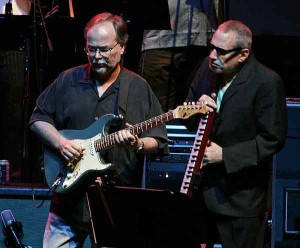By JON M. GILBERTSON
Special to the Journal Sentinel
MILWAUKEE — When Steely Dan got on stage at the Marcus Amphitheater on Friday night, it quickly proved that, nearly 3 1/2 decades after its debut, it is still a gigantic incongruity in the history of the 1970s, of California music and of rock ‘n’ roll in general.
Reelin’ in the years? Yes, and then some.
The main oddity was and is this: The core duo of Steely Dan, singer-keyboardist Donald Fagen and guitarist Walter Becker, achieved mass appeal with an amplified, rocked-up version of 1950s cool that still takes much of its breezy energy from the West Coast jazz of Chet Baker rather than the more lauded and harsher East Coast bebop of Miles Davis et al. (Not to mention a name drawn from one of the most devoutly lurid passages of Beat writer William S. Burroughs.)
With the help of a punchy four-piece horn section, two backup singers and the standard rock-band complement (bass, guitar, drums, keyboards), Fagen and Becker maintained what really was a long look back at how Baker and his audience must have anticipated an easy future of personal jet packs, video phones and ever-larger tailfins.
This had its ironic side, of course, unless Fagen, in sunglasses and dinner jacket, really wanted to look like a pasty Ray Charles while sitting down behind the keys, or unless the feather-light reggae of “Any World (That I’m Welcome To)” was meant to stand up to the heaviest Bob Marley tracks.
On the other hand, Steely Dan’s music did carry strong reminders of the possibilities of the “fusion” subgenre: the volume and edge of rock meeting the muted showboating and deep-background technique of jazz. Becker was responsible for a lot of this amalgamation: His avuncular, professorial demeanor gently belied the pointed dexterity of his guitar solos.
For legends, too, Becker and Fagen came across with near-maximum self-effacement, guiding the band under mildly watchful eyes rather than forceful leadership. They gave the right glint of wry humor to the melancholy decay of aging in “Hey Nineteen” and sprinkled the slow party vibe of “Josie” with a pinch of campy fairy dust.
There were signs of aging: for example, the ease with which the backup singers buried Fagen’s lounge-Dylan vocal cleverness or the super-relaxed and elongated pace of “Aja,” a neo-classic suite that needs every surge it can get. But it’s difficult if not impossible to think of another band (or collective, really) quite like Steely Dan.
A former member of Steely Dan and the Doobie Brothers — the latter a more representative 1970s band — Michael McDonald opened with his own distinctive voice: an indefatigable and instantly recognizable falsetto with a low tone not unlike that of a shout in an oak barrel.
With his experienced band, he took on Doobie faves such as “What a Fool Believes” as if he had recorded them yesterday; his takes on obvious Motown choices like Smokey Robinson’s “I Second That Emotion” were less successful. Fagen knew better than McDonald that an inimitable voice requires material to match.
From Milwaukee Journal Sentinel, July 8, 2006


No comments yet.